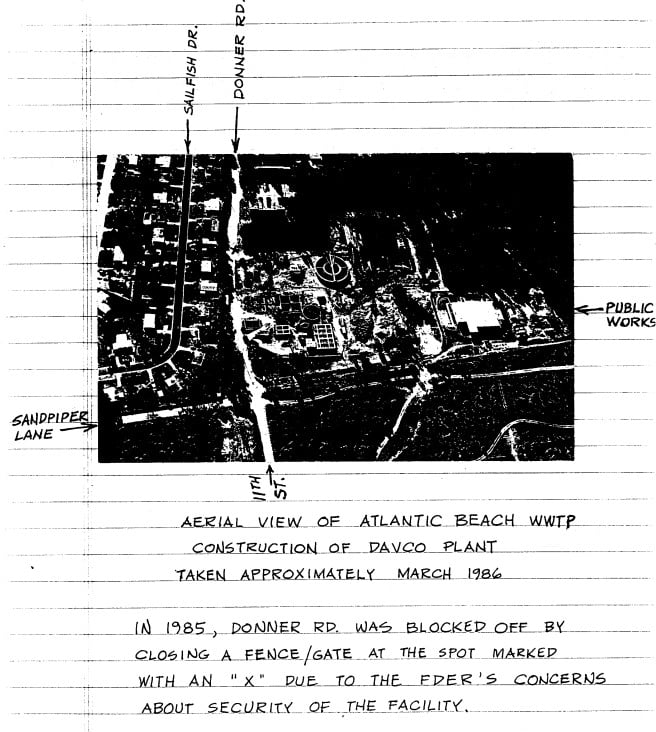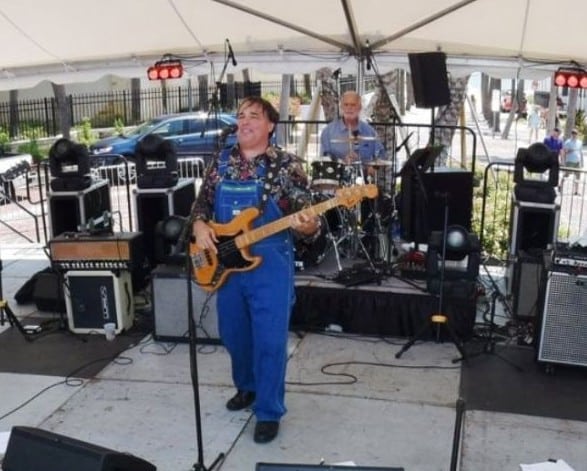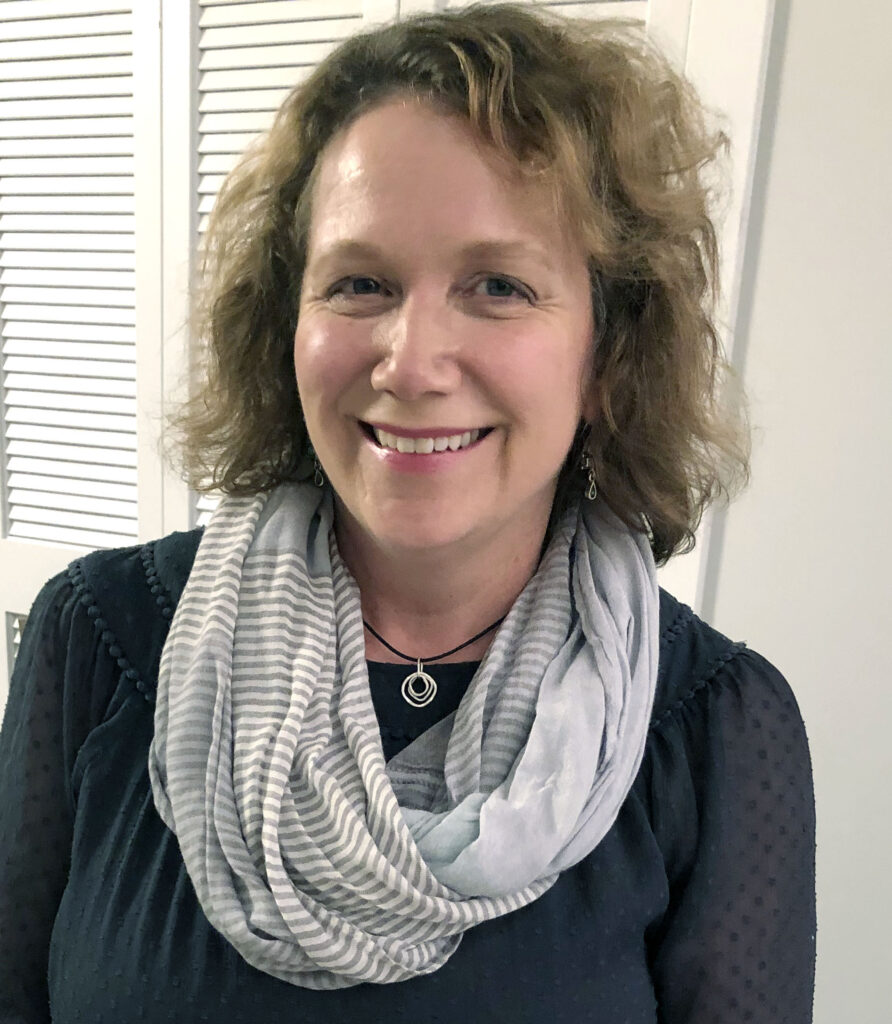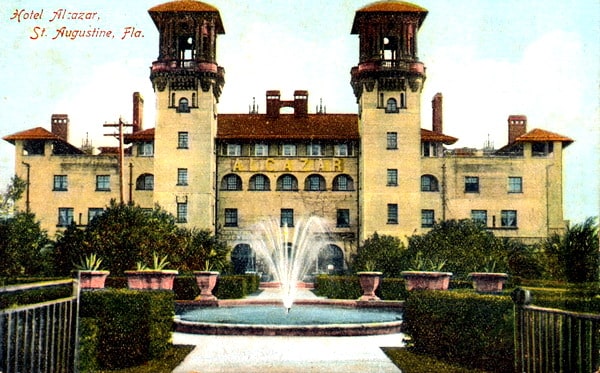
On the night of February 21, 1994, the Atlantic Beach Fire Department responded to a fire in the Donner Road and Jordan Street area. The engine had a quick route to the blaze: Plaza to Sandpiper Lane and then left on Donner. That would have been about seven-tenths of a mile.
Unfortunately, the first responders had to travel past Sandpiper to Mayport Road and backtrack up Donner to Jordan. Not the most direct route, and nearly double the distance due to the detour. By the time the engine arrived, the building was consumed in flames. A single mother lost her home and belongings.
According to former Atlantic Beach Police Chief David Thompson (1983-2008), “There was a locked gate across the eastern end of Donner Road. The fire department had a key to the lock. They could either stop and unlock the gate or take Plaza to Mayport Road. I recall the fire chief timing it and determining that there was a significant delay in the response time due to the locked gate.”
While the Atlantic Beach Fire Chief wanted the gate removed according to Thompson, some residents argued that since the difference in response time was only a matter of a few minutes, the gate should remain in place.
“The fire chief told those people to hold their breath for a couple of minutes,” Thompson remembered. Those few minutes could be the difference between life and death in a rescue situation.
Why did the City of Atlantic Beach build and maintain a gate across an Atlantic Beach road that inhibited direct access to Atlantic Beach residents who wished to travel to the other side of Atlantic Beach? If Atlantic Beach residents living in the Donner area wanted to drive to the city hall, the beach, or any destination on the eastern side of their Atlantic Beach community, they had to travel west to Mayport Road, turn south, and then east on Plaza. Similar to the dilemma the public safety officials faced.
What appears to be the official reason comes from a grainy black-and-white photo provided by current Atlantic Beach City Clerk Donna Bartle. The handwritten notes on the page state, “In 1985, Donner Road was blocked off by closing a fence/gate due to FDER’s concerns about the security of the facility.” There was no name attributable to the quote. Bartle presumed it was the public works director at that time. The facility in question was the Atlantic Beach Wastewater Treatment Plant (labeled as WWTP on the map).
According to Thompson’s recollection, a second gate separated the plant from the public. It may have been located on Sandpiper Lane. A survey map from the city shows a barrier on Donner Road, just east of Jordan Street. There is no such line on Sandpiper. If there was no gate on that side, that begs the question of “Why?” If the gate on Donner was to protect the WWTP, then why was it not protected on the other side of that gate? Were there other reasons for the gate?
Minutes from the City Commission meetings of March 14 and March 28, 1994, offer two more possible arguments why the gate separated two parts of the community: Traffic and crime.
William “Bill” Gulliford, who represented the Donner Community Development Corporation (DCDC) at that time, confirmed that a building company wanted to construct single-family homes in the Donner area but would not do it with the closed egress and ingress point at the eastern end of Donner Road. The minutes of March 14 corroborate his recollection.
Sharette Simpkins, the president of DCDC in 1994 and a 1995 EVE Award recipient for her community volunteer service to revitalize the Donner community, said Gulliford was a “big help” with rehabilitating the Donner area.
“In the 1990s, some of the neighborhoods were living as though they were in the 1950s,” Simpkins said of Donner. “Piled-up trash, problems with running water, poor roads, dilapidated homes, and street workers. With exceptions like Gulliford and Atlantic Beach City Manager Jim Jarboe, the City of Atlantic Beach did not care.” She also remembers the fire of February 1994.
According to the March 28, 1994, City Commission minutes, Atlantic Beach Mayor Lyman Fletcher said, “The reason to provide the Donner community with access was to protect and promote the residential character of the city. The city had grown very quickly and as the city grew to be more dense, citizens needed to be able to get along with one another.”
Some Atlantic Beach residents said opening the gate would create a shortcut from Mayport Road, up Donner, to Sandpiper and then through the Selva Lakes community out to Seminole Road. Sam Kimball, a resident of Selva Lakes and a member of the Board of Directors of Selva Lakes Association, Inc. at that time, said increased traffic was the main concern for him and his neighbors. He and his wife “were chiefly concerned that, according to the plans shown us, our house would have been directly opposite the intersection and that we would be at risk of a car crashing through our backyard fence.”
At the March 28 meeting about 150 people packed the Atlantic Beach Commission chambers. Kimball delivered petitions signed by 170 residents. Their concern reflected the expected increased traffic for their community.
Kimball recently recalled, “When the city redesigned the intersection and explained how the project was intended as a step toward integrating a disadvantaged neighborhood into the community, we felt reassured.”
If both the chiefs of the fire and police departments called for the removal of the fence, why did it take years to remove it? Why the delay despite the concerns and warnings from the public safety officials?
There was a “lack of political power in the Black community,” Thompson said. “I don’t think Donner received a lot of attention and there was a lot of pushback to opening the gate.” Possibly, he thought, because there was a concern in the Selva Lakes area about the “negative impact on their investments and development should the gate be removed.”
Joyce Freeman, who was born and raised in the Donner community, believed crime and race created the fear factor. In the era of the gate, she said, “The only white men and women who came to Donner were the mailman, milkman, insurance man, and the man who came to pick up his housemaid.” She remembers the fire and, according to a Florida Times-Union article in February of 1995, “nothing had been built in the Donner area from the time she was a little girl until about 1990.” When interviewed for this article, she said Mayor Fletcher “connected the community by removing the gate.”
By 1995, Beaches Habitat had built its first house in the Donner community. According to Freeman, that was the “beginning of the diversification of the Donner community.” Today, Freeman serves as the Family Services Director for Beaches Habitat.
Gulliford, who served as Mayor of Atlantic Beach from 1988-1993, also believes there could have been a racial consideration.
Thomson said the gate on Donner Road “represented all the wrong things both socially and from an EMS [Emergency Medical Services] standpoint. Yes, it was for the security of the WWTP but it also was a way to separate two communities within Atlantic Beach: Selva Lakes and Donner.”
Donner, just west of the gate, was a “high crime area” with challenges, according to Chief Thompson. “DCDC had great ideas to improve quality of life. Simpkins, Freeman, and Gulliford were instrumental in changing the vibe in that community. They recognized we could not arrest our way out of the crime issues.”
Kimball of the Selva Lakes Association said his neighbors also had concerns about “the high crime rate and drug trafficking in the Donner neighborhood.”
Joanna DeLoach Fletcher, the late mayor’s wife, said the gate’s construction allowed people to walk but not drive around it to get to Sandpiper Lane and the eastern side of Atlantic Beach. In rainy weather, it was a muddy mess to traverse. “If it was not constructed for racial reasons, then fear of the Donner neighborhood played a major role in its construction and maintenance over the years,” she said.
Simpkins echoed this sentiment. While there was a concern about crime, if you looked at how the gate was erected, “it was not going to stop potential criminals.”
On March 28, 1994, the Atlantic Beach City Commission voted 5-0 to open the gate that had closed off the eastern end of Donner Road.
If there were concerns about the security of the WWTP, why was the gate removed in 1994?
Former Chief Thompson said, “Over time, relative to security, I know the hazardous chemicals were secured in locked gates within the plant, and security measures including motion sensors and hazardous chemical release sensors were installed. As the security technology evolved, the necessity for the fence was no longer as important as it was in the 1980s.”
“In the end, the need and want to open access proved to be bigger than the fear.” DeLoach Fletcher said.
When the City Commission voted to open the gate for a six-month trial period, it created a twenty-member volunteer ad hoc committee. Freeman, Gulliford, Kimball, and Simpkins were among the members. Their charge was to monitor the gate opening and report their findings. Each of the four told me they did not remember meeting.
Chief Thompson said the same. “There were concerns raised relative to the impact on the neighborhoods nearby. I lived in Selva Linkside for many years, and I never saw any problems relative to the opening of the gate. The gate was opened, the roadway paved, and the fire department was able to improve their response time to this part of the community.” This sentiment was repeated often by those interviewed for this article.
“If anything,” Thompson added, “we increased traffic on the Donner Community as the opened road became a convenient cut-through to Mayport from Linkside.”
Simpkins had a similar recollection. “Most of the people I saw coming through the gate were bicyclists coming from the inner part of the city into the Jordon Park area.”
In a September 1994 meeting, the City of Atlantic Beach voted to “remove the cyclone fence gates,” pave the road and build a sidewalk for pedestrians and bikes. According to a Beaches Leader report, Atlantic Beach Public Works Director Bob Kosoy said, “I haven’t heard any complaints… Seems like more people are using it going toward Mayport Road than the other way around.”
“Once the gate was removed, it was a non-issue,” Gulliford said.
Fast forward to September 2023, when the City of Atlantic Beach completed an 18-month improvement project on Donner Road. It included wider traffic lanes and a larger sidewalk to accommodate bicyclists and pedestrians. At the dedication of the revamped road, Mayor Curtis Ford said, “Donner Road is a key east-west route in Atlantic Beach that takes us across Mayport Road. I’m hoping that the continuation of our Complete Streets Plan will make this an active byway heading east to the beach from the western part of our city.” (Beaches Leader, 9/14/2023).
Joyce Freeman believes today that the Donner story “shows how as a community we can work for good. Rather than stand on the side and scream and holler, stand tall and act.”
- About the Author
- Latest Posts
I invested 33-fulfilling years of my life as a classroom teacher. Starting with 7th-grade students and ending with college students. Along the way, I have written thirteen (published) books, written and recorded two music CDs, have written an upbeat blog since May of 2010, produced a monthly podcast channel (for five years), and created original videos for my YouTube channel (for more than a decade). I have had the pleasure and honor to deliver keynote talks and workshop facilitations in every region of the United States. I recently completed the manuscript for my first novel and am currently seeking representation for that work.
One of my community service activities sees me working with the Baptist Medical Center Beaches Pet Therapy Program. This worthwhile service brings smiles and comfort to staff, patients, and family members.
Why do I do what I do? Conversation (true dialogue) has become a lost art. Collective monologues have taken center stage. Authentic questions about the person in front of us have given way to either diatribes or inarticulate silence. I believe to build community we must have meaningful, at times difficult, and yet respectful conversations about people, places, and purpose. Before we can do that, we must see the person in front of us.















